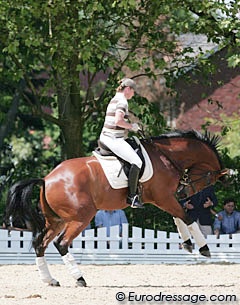
With some horses it is very easy to tell if they are listening to you and are with you every step or not. With others it can be a lot more difficult and while we may know our horses very well it is impossible to guess exactly what they are thinking. One of my horses makes it perfectly clear to me that he is listening, by the position of his ears, by the softness of his breath, by the attitude of his expression, and the effort he puts into the things I ask of him.
However, there are some days when he comes out a little fresh or perhaps a little cheeky and you know immediately that this is a day that he will do everything he can to pretend he cannot hear you. He will avoid the leg and prick his ears of to the side of the arena and sometimes even give me a little squeal of boisterous play.
On these days I have to be always one step ahead, because if I cannot retain his concentration and let him take advantage of that for even a second, then the pricked ears and boisterous squeal become an impromptu capriole or reining spin. My mum used to say that our Weimaraner “Maddie” had “selective hearing” because she could hear you perfectly well when you were calling her for dinner, but if she was in trouble she could not, quite conveniently, hear a single thing. So on these “selective hearing days” it is up to the rider to take charge immediately, but without generating more tension.
Some riders would pull the horse's head in deep or to one side and use strong leg aids, or speedy fast mini circles, to put the horse into submission. Maybe a very strong rider, less technically apt, would have some success in getting the horse under control, but a smart horse, would soon learn to turn their selective hearing into deafness and become either numb, or dangerous in the process.
My trainer says instead to find a way to keep the horse always thinking, so there is no time for him to let his boisterous side take charge. So if I feel that Batialo is in a “I might not listen to you today” day, I very quickly start doing things to keep his mind on me. If you are a good rider technically, you may not even see these things from the ground, but you are working silently and subtly, to let the horse know that you are there and you are in charge.
At the walk, flex a little to the left, then a little to the right, gently to each side, then ask a little left leg to see if he moves off and then a little right leg to check he is even and moving away from both sides. Then, the minute he points even a tip of the ear off to one side, ask him to move away from the leg, or bend a little to the right, or begin transitions, in and out of trot. Do not get stuck in the one thing, and think 'oh great this is good'. Do one thing and then think 'now I should remind him again that I'm here, and I’m in charge, and I’m keeping his attention on me.'
Sometimes, this is all impossible, because Batialo is having a “selective hearing and chaotic stallion day” and he wants to have a spin out of control party, with me as his guest. In this case I either have to ride him forward, to let off a bit of steam (much easier said than done), or I must close myself around him like a bird protecting her eggs, and make myself heavy, and reassure him than I am there, and I am stable and I am not going to his party. In either case, a rider needs to adopt this scenario with conviction, because if I choose to push Batialo forward, and then hesitate, he knows and then I’m definitely at his party.
If I choose to make myself a ball of reassuring stability, I must not lose my balance, or release my core, or lose the contact for even a second, because then the ball becomes a flat tyre, and again, it’s party time.
On other horses, they might never actually throw a party, but are more the 'always trying not to listen' types, sometimes even sticking their head up in the air, neighing out, drifting off into outer space when you are trying to do a circle etc. With these horses it is sometimes better not to try to do too much and just concentrate on a single thing. A horse that is a bit chaotic mentally needs a rider that sticks to a certain pattern, and this is where precision can become your greatest tool.
If you choose to ride a circle, make it perfect, forward, and even if you lose his attention, focus on your own line and on keeping yourself as direct and as delicate as possible in your aids. I find that if you focus on precision and repetition, that these horses will gradually find calm from your technical direction and begin to trust in you to lead them, and open their ears up to what you have to say.
If your horse has neither of these traits, then a patient caring rider will understand that a horse is a living animal and not a mechanical device. Like us a horse has its own personality and curiosity about the world around him. The rider will therefore try to discover a way to capture his attention, rather than beat the personality out of him. On the other hand, if your horse always listens to you and has perfect hearing, well then you are just lucky.
by Sarah Warne for Eurodressage
Photo © Astrid Appels
Related Link
Sarah Warne's Classical Training Articles